- Scientific name: Crataegus schizophylla Eggleston
- Species of Greatest Conservation Need (MA State Wildlife Action Plan)
- Endangered (MA Endangered Species Act)
Description
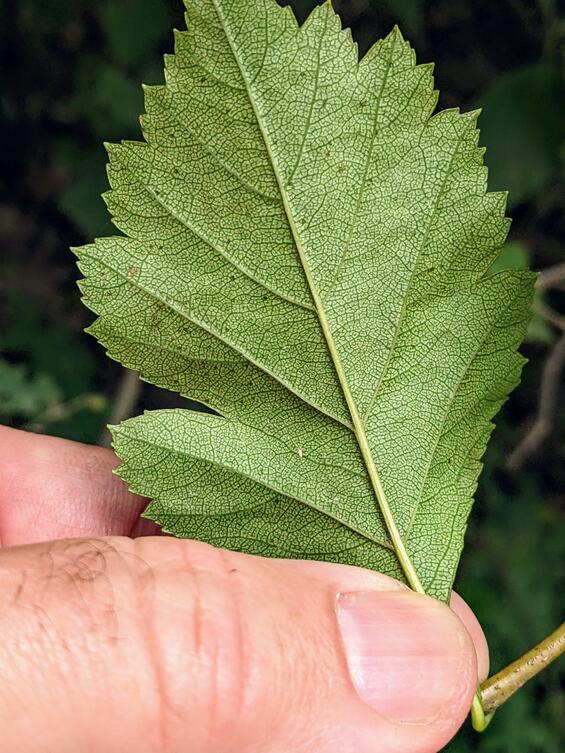
Split-leaved hawthorn leaf undersurface showing veination.
Split-leaved hawthorn is a tall shrub or short tree, two to four meters (6.6-13 ft) in height usually rising from a single stem that can be 15 cm (5.9 in) in diameter. The new growth of twigs is flexuous and smooth. After a year, the twig color is tan, and older twigs are gray. The thorns on twigs that are a year old are shiny black and up to 7.5 cm (3 in) in length and extremely sharp. The leaf petioles are 2-12 mm (0.08-0.47 in). When growing in sunlight, the upper leaf surfaces are smooth and shiny, broadly ovate to obovate in shape, though quite variable, up to 8 cm (3.1 in) long and 3-4 cm (1.2-1.6 in) in width, and somewhat thick and firm. The margins are sawtooth with minor lobes. The secondary veins 4 to 6 per side, best seen on the underside, are clear and run straight out to the tips of the pointy lobes. The flower clusters are 5-20 flowered; the flowers 12-15 mm (~0.5-0.6 in) in diameter with sepals 3-4 mm (0.12-0.16 in), stamens 10, anthers pink; styles 1-3. The fruits are green at first but then ripen to a deep red. They are round in shape, and 1 cm (0.4 in) in diameter.
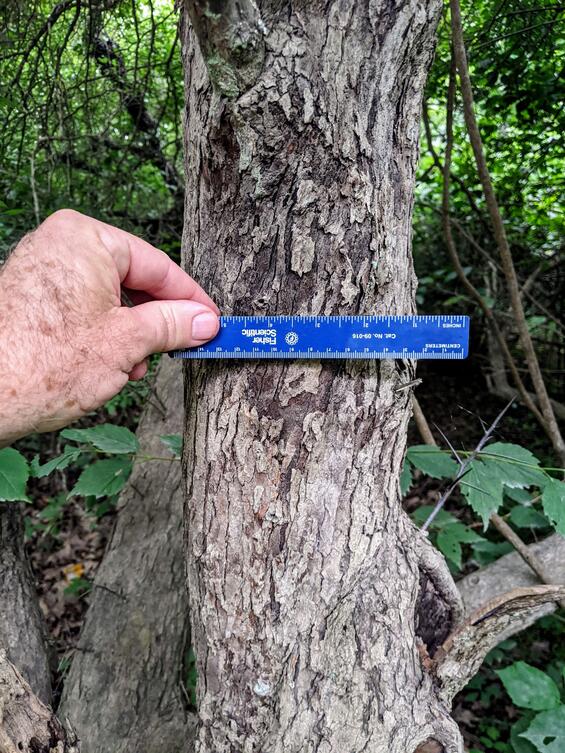
Main stem (trunk) of split-leaved hawthorn.
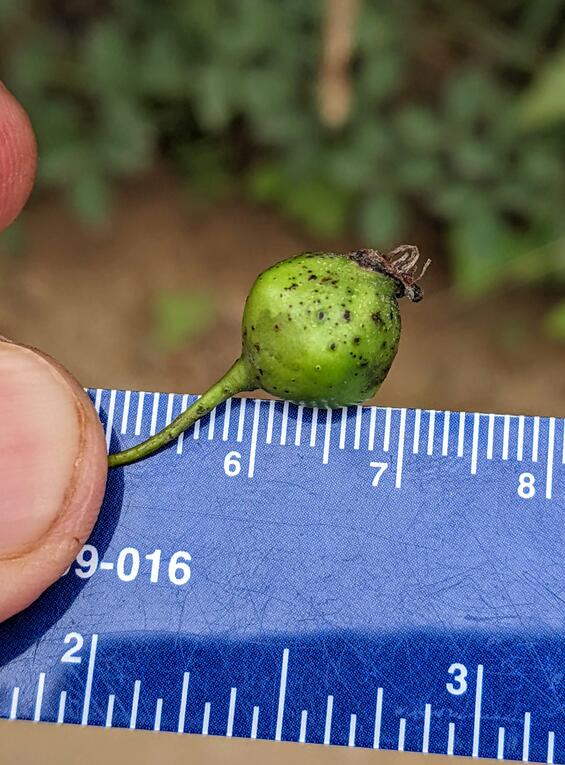
Fruit of split-leaved hawthorn in mid-August
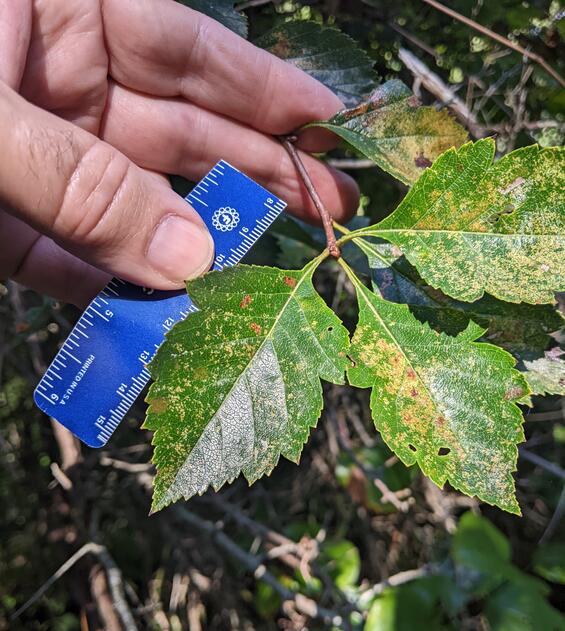
Typical outmost leaf of split-leaved hawthorn when grown in sunny conditions. The outermost (long shoot) leaves tend to have more “split” appearance with sharp lobes.
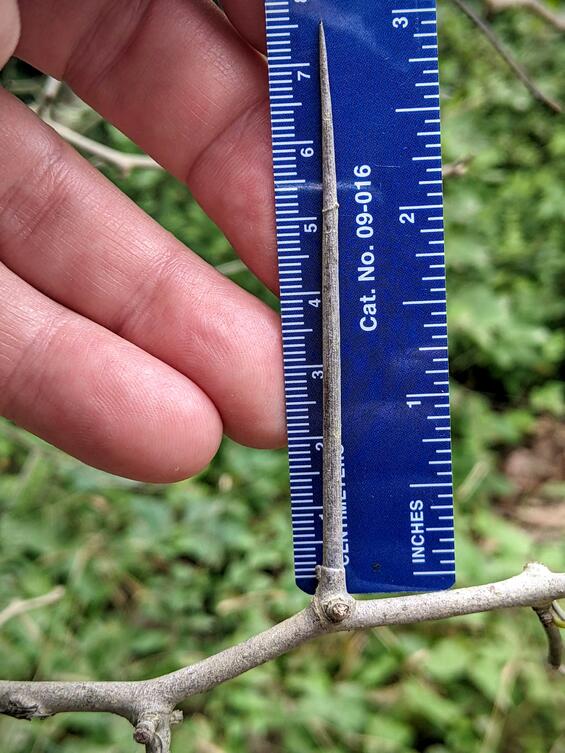
Showing thorn length of 7.5 cm
Life cycle and behavior
Hawthorns are a sturdy deciduous woody species that are known to be quite long lived.
Population status
This species is known only from Martha’s Vineyard, the only known location in the entire world and thus is considered by ecologists as a very narrow endemic species, ranked as a G1 or globally critically imperiled. It had been considered historic after the one known population was not surveyed for many years. That was rediscovered in recent years and maintenance work completed on the site so that this small population might begin to recover. Thanks to the work of two independent botanists, we know of populations in 4 towns on the Vineyard, with Edgartown having 6 populations. Populations in two towns consist of a single tree (Curtin, pers. comm 2025).
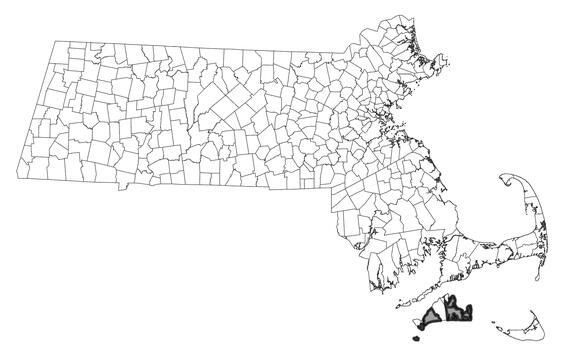
Distribution in Massachusetts
1999-2024
Based on records in the Natural Heritage Database
Habitat
On Martha’s Vineyard, the habitat occurs in the glacial outwash plan within scrub oak barrens and maritime coastal plant communities, not in pine or oak forests. These can quickly become overgrown with grape vines and other vegetation cover. Hawthorns nearly universally need consistent sunlight and low humidity conditions to maintain health.
Healthy habitats are vital for supporting native wildlife and plants. Explore habitats and learn about conservation and restoration in Massachusetts.
Threats
Sites can quickly become overgrown with grape vines and other vegetation cover and need frequent clearing and “daylighting” but trimming away growth around the shrubs and opening the canopy. Hawthorns nearly universally need consistent sunlight and low humidity conditions to maintain health. With climate warming, higher humidity and higher nighttime temperatures are expected (Staudinger et al. 2024). Hawthorns are susceptible to rusts and fungal pathogens that flourish in more humid conditions, making climate change a threat to this species.
Conservation
More survey work is needed as several populations have quite recently been discovered which means that there are likely even more out there to be discovered. Monitoring populations is essential to make sure that the plants have enough light and air and are not overgrown with invasive species or wild grape or similar vegetation. Management is also essential to clear brush and trees around these plants to give them more room to grow and lower humidity levels which will help prevent fungal pathogens. Prescribed fire might be a helpful tool in improving the habitat conditions. Much more research is needed to determine optimal conditions for plant growth and reproduction, seed germination and survival of ex situ plantings.
Acknowledgements
MassWildlife acknowledges the expertise of Margaret Curtin and Gregory Palermo, who contributed substantially to the development of this fact sheet through research, survey work, iNaturalist posts, and a listing proposal for this species.
References
Curtin, Margaret 2025. Research botanist associate for Polly Hill Arboretum. Email communication to Robert Wernerehl, state botanist of Massachusetts.
Haines A (2011) New England Wild Flower Society’s Flora Novae Angliae: a manual for the identification of native and naturalized higher vascular plants of New England. Yale University Press. 1008 pp.
Palermo, Greg. 2023. Species listing proposal for Crataegus schizophylla. Massachusetts Natural Heritage & Endangered Species. Massachusetts Division of Fisheries and Wildlife, Westborough, MA.
Phipps, James B., J. B. Crataegus schizophylla - FNA. Flora of North America North of Mexico [Online]. Website http://dev.floranorthamerica.org/Crataegus_schizophylla [accessed 28 March 2025]. Page version 30 July 2020. In: Flora of North America Editorial Committee, eds. 1993+. Flora of North America North of Mexico [Online]. 25+ vols. New York and Oxford. Vol. 9.
POWO (2023). Plants of the World Online. Facilitated by the Royal Botanic Gardens, Kew. Published on the Internet; http://www.plantsoftheworldonline.org/
Staudinger, M.D., A.V. Karmalkar, K. Terwilliger, K. Burgio, A. Lubeck, H. Higgins, T. Rice, T.L. Morelli, A. D'Amato. 2024. A regional synthesis of climate data to inform the 2025 State Wildlife Action Plans in the Northeast U.S. DOI Northeast Climate Adaptation Science Center Cooperator Report. 406 p. https://doi.org/10.21429/t352-9q86
Contact
| Date published: | April 10, 2025 |
|---|